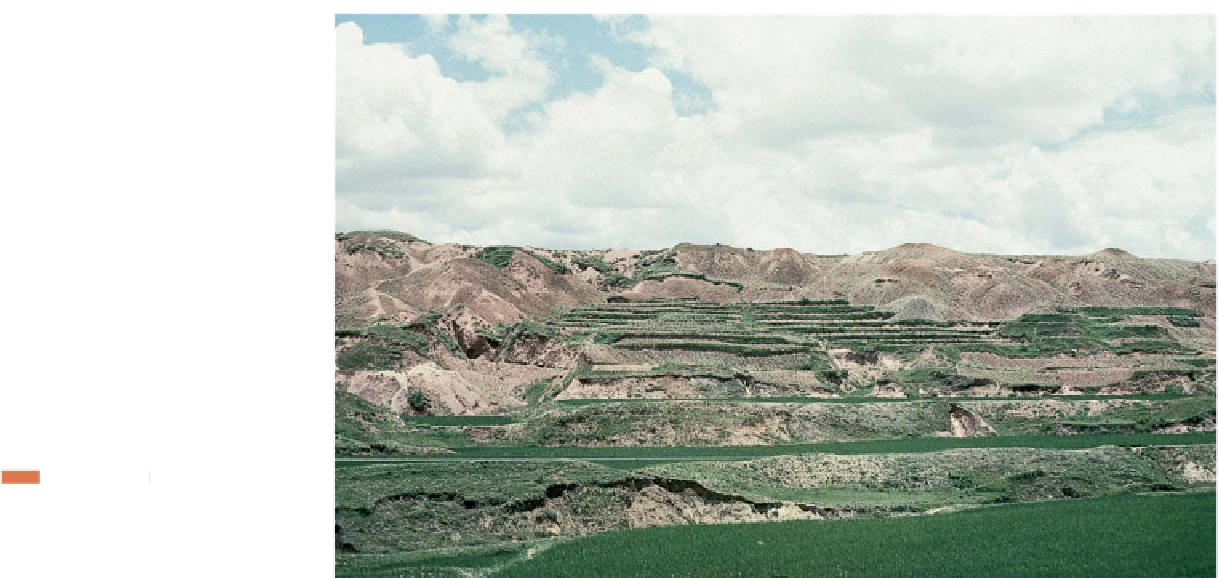Geography Reference
In-Depth Information
Figure 13.14
Guangxi-Zhuang, China.
Overuse
of land in this area of China was lead-
ing to the collapse of formerly sound
terracing systems.
© H. J. de Blij.
Waste Disposal
If anything has grown faster than population itself, it is
the waste generated by households, communities, and
industries—much of it a matter of bulk, some of it a
source of danger.
The United States, the world's largest consumer
of resources, is also the largest producer of
solid waste
,
debris, and garbage discarded by those living in cities,
industries, mines, and farms. According to current esti-
mates, the United States produces about 2 kilograms
(4.5 pounds) of solid waste per person per day, which adds
up to more than 226 million metric tons (250 million tons)
per year. But the United States is not alone. Other high-
technology economies with a high ratio of disposable
materials (containers, packaging) face the same problems.
Disposal of these wastes is a major worldwide prob-
lem. The growing volume of waste must be put some-
where, but space for it is no longer easy to fi nd. In poorer
countries waste is often thrown onto open dumps where
vermin multiply, decomposition sends methane gas into
the air, rain and waste liquids carry contaminants into
the groundwater below, and fi res pollute the surround-
ing atmosphere. In countries that can afford it, such open
dumps have been replaced by
sanitary landfi lls
. The
waste is put in a hole that has been dug and prepared for
the purpose, including a fl oor of materials to treat seeping
liquids and soil to cover each load as it is compacted and
deposited in the fi ll.
The number of suitable sites for sanitary landfi lls
is decreasing, however, and it is increasingly diffi cult to
is not the result of a decline in the skills of farmers but
rather of the pressures on farmers to produce more. In
an integrated world food economy, the pressures on land
resources are not confi ned to particular countries; they
permeate the entire world.
Why has
soil erosion
increased so much? Part of
the answer lies in population pressure: world population
is over 7 billion. Associated with population growth is the
cultivation of ever-steeper slopes, with hastily constructed
terraces or without any terraces at all (Fig. 13.14). As the
pressure on land increases, farmers are less able to leave
part of their soil fallow (unused) to allow it to recover
its nutrients. Shifting cultivators (see Chapter 11) must
shorten their fi eld rotation cycle, and as a result their soil,
too, is less able to recover. Altogether 99.7 percent of all
human food is grown in soil (some is grown in water), and
annual soil erosion shrinks the cropland available for agri-
culture. A 2006 study reported that globally about 37,000
square miles (10 million hectares) of cropland are lost to
soil erosion each year.
Soil erosion is caused by a variety of factors: live-
stock are allowed to graze in areas where they destroy
the natural vegetation; lands too dry to sustain farming
are plowed, and wind erosion follows. Soil is a renew-
able resource because with proper care it can recover.
However, it is being “mined” as if it were a nonrenewable
resource. International cooperation in food distribution,
education of farmers and governments, and worldwide
dissemination of soil conservation methods are urgently
needed to solve this “quiet crisis.”









































